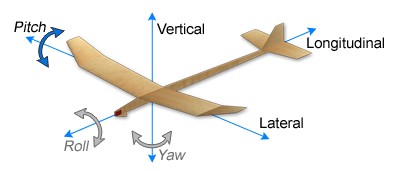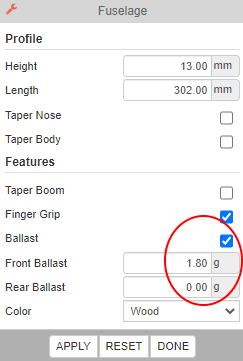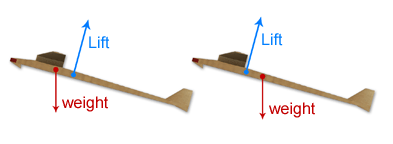Pitch (Longitudinal) Stability
Pitch is the motion when the nose of the airplane points up or down, A disturbance about the pitch axis could occur (for example) by a gust of wind coming up from below the aircraft. This would "catch" the underside of the wings, causing the nose of the aircraft to turn upwards abruptly. So, what would cause the aircraft to return to its original orientation – or level flight? The aircraft must be designed for this specific eventuality and proper design requires that you understand the neutral point and its position relative to the center of gravity.

The Pitch Axis
Center of Gravity
The center of gravity is the "balance point" of the glider. If you were to balance a pencil on your finger, the point on the pencil directly above your finger would be the center of gravity. The pencil is in balance because there is an equal amount of mass on the left and right of your finger. This is the same with a glider. The center of gravity is at the point were the mass on the nose end is equal to the mass on the tail end of the glider.

Glider Center of Gravity
To move the center of gravity towards the nose of the glider, mass should be added to the nose. Use the animation below to adjust the mass at each end of the glider to see how the center of gravity moves. Remember the equation, mass = density x volume. In the animation you can adjust both the volume and the density to adjust the mass. Adjusting the volume makes the circle change in size. The lower the density the lighter gray the circle, the higher the density the darker gray the circle becomes.


Since all of the glider components affect the overall center of gravity, you can adjust the size and/or position of any component to move the center of gravity. An easy way to add or remove mass from either the front or rear of the glider is to use ballast. In the fuselage work area, you will see a checkbox to toggle ballast on or off along with inputs for ballast mass on the front and rear of the fuselage. In real gliders, water is often added to various glider components to shift the glider center of gravity. In our gliders, clay is used to add ballast.
Using ballast is an easy way to change the glider center of gravity, but by using ballast you are adding mass. This is fine if you need more mass to be within design specifications. Otherwise, you may want to consider moving some of the other components to achieve your objective.

Ballast
The position of the center of gravity is very important. It should be below the wing and the optimal position is between ⅓ and ½ of the wing chord. The illustration below should help to clarify this objective.

Optimal Center of Gravity Range
The center of gravity should be below the wing and the optimal position is between ⅓ and ½ of the wing chord.
Neutral Point
The neutral point is the aerodynamic center of the whole aircraft, and can be thought of as a single point through which all lift occurs. Since lift occurs through the wing and horizontal stabilizer, the location of the neutral point depends on these two components (wing and horizontal stabilizer). More specifically, it depends on the size of the wing relative to the horizontal stabilizer and the distance between the aerodynamic centers of the wing and horizontal stabilizer. Use the following simulation tool to see how changes in the wing position, wing size, and horizontal stabilizer size affect the neutral point.



Move the sliders above to see how you can affect the neutral point
The simulation illustrates the fact that we can move the neutral point by changing the size or position of the wing, changing the size of the horizontal stabilizer, or some combination of all. But, recall that the size of the wing and horizontal stabilizer will also affect lift. A good rule of thumb is to design the horizontal stabilizer so that its area is about ⅙ to ⅛ of the area of the wing.
The area of the horizontal stabilizer should be about ⅙ to ⅛ the area of the wing.
Positioning the Center of Gravity and Neutral Point
The total weight of the aircraft acts through the center of gravity and always points to the center of the Earth. The location of the center of gravity is important because any rotation in the aircraft, such as a disruptive gust of wind causing the nose to tip upward, will occur around the center of gravity. So in order for the aircraft to return to level flight, another force must push it back. For a well designed aircraft, lift will cause the aircraft to rotate back to a level orientation.
We have also learned that lift is a force and we've established that lift for the entire aircraft can be thought to act through the neutral point. Any force acting on the aircraft will cause a torque or rotational force about the center of gravity. Why does all this matter? In the illustration below, we can imagine what would happen in two different scenarios. In both cases, a gust of wind under the wings has caused the nose of the aircraft to tip up. When the gust stops, lift will cause the plane to rotate counter-clockwise in the image on the left. This counter-clockwise rotation will bring the aircraft back to stable, level flight. In the image on the right, lift will cause the aircraft to continue to rotate clockwise. The difference is the location of the neutral point relative to the center of gravity. It is important for longitudinal stability that the neutral point be located behind the center of gravity.

Longitudinal Stability
The distance between the neutral point and the center of gravity is referred to as the static margin. The static margin will always be a positive number if the neutral point is behind the center of gravity. A good rule of thumb is to design your aircraft such that the neutral point is less than 1 inch, or 25.4 mm behind the center of gravity.
A good rule of thumb is to design an aircraft with a positive static margin that is less than or equal to 1 inch, or 25.4 mm.